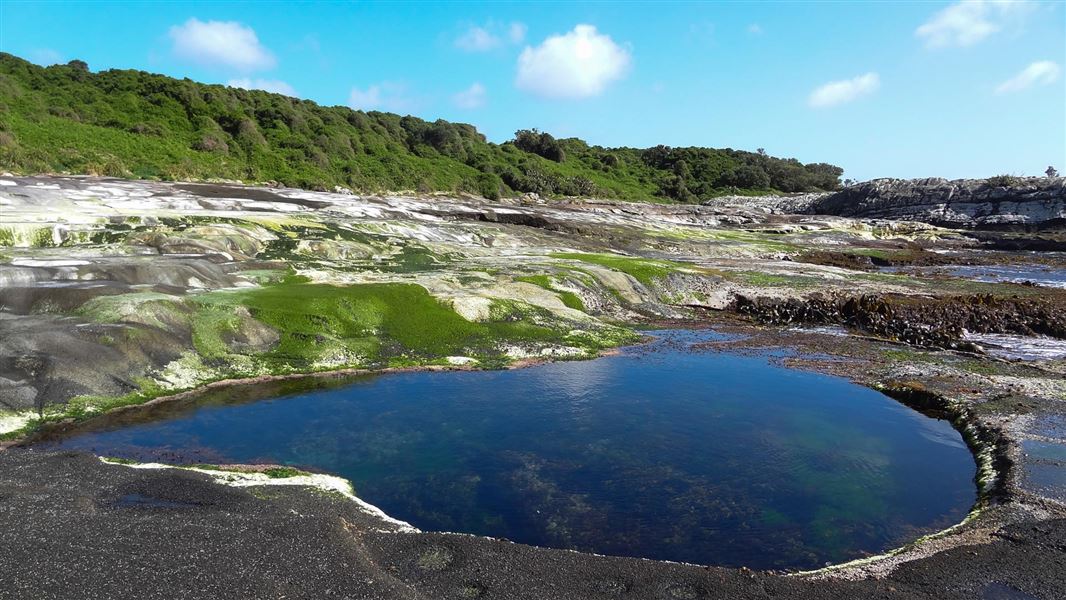
Introduction
The Chatham Islands have been isolated for more than 80 million years, long enough to develop many plants found nowhere else.Of the 388 indigenous terrestrial plant species on the Chatham Islands, 47 (about one-eighth) are endemic, meaning they can't be found anywhere else in the world.
Endemic species include forest trees, several giant herbs and seaweeds. Even the local flax is unique. Most well known of the endemics are:
- Chatham Island forget-me-not (Myosotidium hortensia)
- Chatham Island Christmas tree/rautini (Brachyglottis huntii)
- Chatham Islands kakaha (Astelia chathamica)
- Soft speargrass (Aciphylla dieffenbachii)
What makes Chatham Islands plants unique?
Plants of the Chathams show a much higher proportion of coloured flowers than in mainland New Zealand. Examples are Chatham Island forget-me-not (blue), linen flax (blue), Chatham Island geranium (pink), swamp aster (mauve), keketerehe (purple), and giant sowthistle (purple).
Leaves of Chathams species are also often fleshier and trees bigger than their New Zealand counterparts. Chathams plants do not generally show juvenile forms.
View a Chatham Islands plants factsheet (PDF, 368K)
Affinities with other regions
Plants have colonised the Chathams in the past from both the northern and southern parts of the New Zealand region.
Species with northern affinities include:
- Chatham Islands nikau (possibly related to Rhopalostylis baueri subsp. with affinity to the palms of Norfolk Island and the Kermadec Islands)
- kowhai (Sophora chathamica, also found in western North Island)
- three hebe species (H. barkeri, H. dieffenbachii and H. chathamica).
Those with a southern or subantarctic connection include:
- swamp heath (Dracophyllum scoparium, found also on Campbell Island),
- keketerehe, closely related to a shrub daisy of Fiordland and Stewart Island) and
- rautini (closely related to Brachyglottis stewartiae of The Snares, Solander Islands and small islands in Foveaux Strait)
- Chatham Island forget-me-not: blue flowers, large leaves - distinctively Chatham Island, and a favourite with gardeners.
Environmental influences
The oceanic setting of the Chatham Islands has had a profound influence on the plant life. Winds sweep the islands, bringing gales, salt spray, cloudy skies, frequent showers and occasional blasts of cold air, but temperature extremes, droughts, frosts and snow are rare. Annual sunshine hours are about half those of the sunny parts of the New Zealand mainland. Plants are adaptated to these conditions in many ways. Some, such as tarahinau (Dracophyllum arboreum), have wind-resistant needle leaves.
Protective leaf and twig furriness, is a feature of the tree and shrub daisies, and the indigenous trees have the remarkable ability to layer themselves after having been blown over.
Other species have developed giant leaves e.g.,megaherbs such as Chatham Islands forget-me-not and giant sowthistle (Embergeria grandifolia). Gigantism is also displayed by the trees and shrubs.
Chatham Islands karamu (Coprosma chathamica), which grows into a forest tree, is by far the largest species in a genus of shrubs. Tree koromiko (Hebe barkeri) is also the largest of its genus and akeake (Olearia traversii) is one of the largest tree daisies on earth. Button daisy (Leptinella featherstonii) is a woody shrub - all other members of its genus are creeping herbs. These significant enlargements may be due to the climate, long isolation and high soil fertility.
Megaherbs, the button daisy and fleshy herbs such as Cook’s scurvy grass (Lepidium oleraceum) evolved and thrived in highly fertile soils developed through the effects of millions of sea birds inhabiting the islands. The decline in the abundance of these plants is partly due to the loss of sea birds.
The cool humid overcast climate has influenced the plants of the Chathams in other ways. Tree ferns predominate in the forests, where they provide germination sites on their trunks for seedlings of forest trees, as well as filmy ferns and orchids. Peat has developed as a result of thousands of years of accumulated plant matter, mostly from sphagnum moss and the rain of tarahinau needles.
Introduced plants
People have lived in the Chathams for many hundreds of years and many plants have been introduced. The most significant introduced tree is karaka or kopi (Corynocarpus laevigatus), brought centuries ago from mainland New Zealand by Moriori. It was cultivated in groves, eventually becoming widespread and self-perpetuating in the forests. The kernel/seed of kopi is highly toxic if eaten raw, but was an important source of carbohydrate when prepared appropriately.
Other mainland New Zealand plants brought more recently and now well established include cabbage tree, tree fuchsia, tutu, karamu and flaxes.
More sinister are weeds from other countries. Gorse, broom, selaginella, old man’s beard, sweet brier,cotoneaster, elderberry and Himalayan honeysuckle are all a worry. Worse though is Chilean guava, also known locally as cranberry, which seems superbly adapted to flourish in Chatham Island peatlands, progressively elbowing out the indigenous vegetation unless controlled.
Conservation
Before widespread clearance, over 90 percent of the islands were covered with a mosaic of forest types with scrub and rush swamps covering the balance of the area.
However, sufficient remains of the natural character of the Chathams to be apparent almost everywhere. The network of protected areas on the main islands contains much of the representative fauna, flora and habitats, and more is being added steadily through the interest and generosity of landowners.
Enhanced conservation management in recent years, is resulting in an increasing quality of natural habitat - through the removal of weeds and possums and fencing out stock, and the restoration of populations of threatened plants.